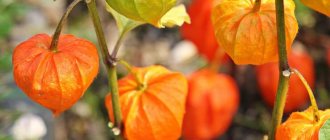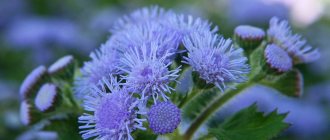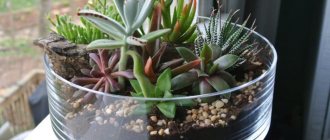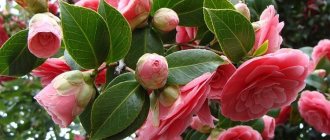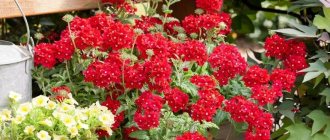Photo: s30556912786.mirtesen.ru Are you looking for something to decorate your garden and yard when the first spring flowers fade? Something that will be quite elegant and bright, but at the same time easy to maintain? Then pay attention to verbena - an elegant herbaceous plant that will cover the area with a colorful carpet. And we will tell you what types of verbena exist and how to care for them!
general characteristics
Verbena belongs to the family of simple and unpretentious herbaceous plants of the same name. These can be small shrubs, a thick flowering carpet, or even tall, straight subshrubs up to several meters tall.
Verbena flowers are always small, up to a maximum of 2.5 cm, but at the same time they are collected in dense inflorescences and brushes. The color spectrum is wide and varied: from white and yellow to pink, dark red and even blue or dark blue.
Some varieties of verbena are actively used in medicine for the treatment and prevention of digestive problems. In cooking, it is often used for flavor in the preparation of preserves and preparations. Medicinal verbena is also in demand among beekeepers and honey lovers.
Photo: domashniecvety.ru
Botanical writing
Depending on the species, verbena can have either erect or creeping stems. The height of the plant ranges from 20 cm to a meter and above. The leaves are dark green, usually elongated oval in shape, slightly pubescent.
The color is very abundant: small verbena flowers are collected in inflorescences of red, pink, white, cream, lavender or deep purple, sometimes with a flirty white eye. Regardless of color, they all have a subtle sweetish aroma that intensifies in the evening.
History and use
Simple and unremarkable at first glance, verbena is a sacred plant. The name itself comes from the Latin “word”, because it was verbena that was used in oaths and spells.
The ancient Celts prepared a drink of love from this flower and created protective amulets against evil spirits. And according to Christian legend, it was this flower that grew at the foot of the cross of Christ on Golgotha, and it was used to stop bleeding in wounds.
Photo: pinterest.ru
Verbena was a symbol of Venus, and was carried in amulet even during battles with enemies. It was believed that it gives beauty and youth, and in children it develops abilities and memory. They believed that verbena brings and preserves prosperity and wealth in the home.
Verbena wreaths strengthened friendships and marriages, and its juice tempered iron for swords and daggers. Healers treated all illnesses with it, and washed their hair with its decoction for headaches and worries. Witches used verbena flowers for their spells and love potions.
Photo: qscaping.com
Columnar apple tree: varieties, care and cultivation (photo)
Application in landscape design
The use of hybrid verbena in landscape design is so widespread that many flower growers and professional gardeners prefer this crop for most areas of area design. Thanks to its unpretentiousness, exceptional decorative properties of rich greenery and a wide range of shades, verbena is used on various objects:
- on clubs and beds to design areas that bloom throughout the summer;
- in mixborders (middle or background for tall varieties);
- in rock gardens to create bright color accents;
- on lawns as dominant elements;
- for designing dense borders (low-growing species);
- hanging flowerpots;
- containers;
- outdoor pots and flowerpots.
With proper care, hybrid verbena can decorate any area of the local area with its lush blooms all summer long.
Types of verbena
There are more than 120 species of verbena in the world, but only a few of the most popular ones are cultivated and propagated at home. Most varieties are South American and grow everywhere from Chile to Canada. But some popular species have spread throughout Europe.
Pharmaceutical verbena
Verbena (medicinal) is the most popular and widespread species in our latitudes. This is a herbaceous perennial with a developed rhizome, which grows in height by 30-60 cm. Small flowers are collected in neat paniculate inflorescences, which begin to bloom in the axils of the leaves.
Photo: sadvokrug.ru
Hybrid verbena
Hybrid verbena is a whole group of selected garden varieties that were bred through long-term crossings of wild species. These are annual species that can be low-growing, large-flowered, or even ampelous. Height is from 20 to 70 cm, and long creeping shoots are good in flowerpots and decorative compositions.
Photo: lafa.ru
Verbena canada
This is one of the classic varieties - a low-growing garden shrub up to 20 cm tall. The bunched inflorescences look interesting, which distinguish this variety from the paniculate ones. The color is white, pink or purple, which contrasts favorably with the bright openwork leaves.
Photo: chrome-effect.ru
Lemon verbena
It is an aromatic perennial shrub that grows up to 2 meters in height. The branched stems are covered with bright green leaves, which, when crushed, emit a characteristic citrus aroma with light notes of lemon balm and mint.
Photo: grow-me.ru
Photo: funart.pro
Verbena tough
This is a variety with long creeping shoots, at the ends of which purple and blue buds bloom. Another interesting feature is the hard, toothed, elongated leaves. In its native Brazil, tuberous verbena is perennial, but in our latitudes it grows as an annual.
Photo: wellywoman.wordpress.com
Verbena Buenos Aires
The popular variety is known by many other names: tall, Brazilian, Argentine, lilac-flowered. In its native South America it is a wild perennial, but in our gardens it is grown as an ornamental annual.
This is a large variety with straight erect stems up to 1.5 meters, decorated with lilac umbrella inflorescences. Buenos Aires verbena looks impressive and, together with its jagged leaves, resembles openwork lace.
Photo: zakupator.com
What problems can you encounter during cultivation?
Despite the fact that verbena is an unpretentious plant, if not cared for properly it can begin to wither. If the humidity level is insufficient, the flower will dry out before your eyes. Affected leaves need to be removed, as well as dried stems.
Note! The watering regime is easy to adjust; just focus on drying the top layer of soil. If a flower grows quickly and gains green mass, but does not produce buds, then the reason may lie in insufficient light
Daylight hours should be at least 12 hours
If a flower grows quickly and gains green mass, but does not produce buds, then the reason may lie in insufficient light. The duration of daylight should be at least 12 hours.
Spacious pot encourages root growth
The pot for verbena should be 1-1.5 cm larger than the earthen ball. In this case, the plant will try to bloom. Poor soil and lack of fertilizers also lead to a lack of flowering.
Therefore, to correctly determine the cause of the problem, you need to analyze the conditions of detention. Only after correcting them can the condition of verbena be improved.
Leaf spot
Small black dots that gradually swell indicate the development of a fungal disease. The difficulty of treatment is that the spores penetrate deep into the tissue, and contact treatment with fungicides is useless. Therefore, the affected leaves and stems are removed, and the plant is sprayed with topaz or foundationazole. Treatment is carried out once every 10 days until complete recovery.
Small black bubbles on the leaves appear when there is a bacterial infection. In this case, treatment is useless. Affected vervain must be destroyed.
Each variety of verbena has its own characteristics. Studying the full description will give you an idea of each species. Compact and small varieties are suitable for the balcony. Large specimens can be planted in flower beds. In any case, when growing, you should follow the rules of agricultural technology described above.
- Why doesn't the verbena plant bloom? There are two reasons for this. Poor watering, which causes the soil to become excessively dry. As a result, the roots do not develop, and little nutrients and moisture enter the stem. The second reason is incorrect or reduced amount of fertilizer.
- Leaf spotting. Purple, brown, and white spots appear on the leaves. This indicates fungal, viral, bacterial diseases. If the spotting has spread to the entire bush, it is destroyed so that neighboring crops do not become infected.
Verbena is a perennial that grows in a variety of conditions. To enhance the growth of green mass and flowering, the gardener must properly care for it. Plants love plenty of sunlight, air and moisture. But you need to be careful with the latter so as not to create a swamp under the bushes. Due to waterlogged soil, verbena will die before our eyes.
Verbena care
The undemanding verbena pleases gardeners with its unpretentiousness to conditions, so it is easy to manage in the garden. If you monitor watering, control the density of crops and avoid excessive amounts of moisture, there will be no problems with it.
Temperature
The ideal temperature for young shoots of verbena is above 20 degrees, and an adult plant feels comfortable even at +10. Abundant flowering will continue at 16-25 degrees, but short-term cooling does not affect the condition of the flower. The main thing is that it is returnable, because the flower does not overwinter in the open ground.
Photo: blogger.belhak.ru
Lighting
Verbena loves light, and the more the better, because with a lack of lighting, powdery mildew and other diseases can appear. The flower tolerates drought and heat better than lack of sun and high humidity.
Photo: provenwinnersdirect.com
Photo: 1zoom.ru
The soil
Verbena does not require special soil preparation or even regular loosening. Only with abundant watering in hot weather is it recommended to fluff up the soil for air circulation, otherwise the roots may begin to rot. And to avoid drying out, use mulch made from regular foliage or ready-made decorative mulch.
The soil for verbena is loose, permeable loam, so if the soil in the area is too heavy, add sand. And to protect the root system from moisture, lay a drainage layer of stones, expanded clay or brick fragments.
Photo: sadovyexpert.ru
Watering
The period of active flowering is the very time when verbena especially needs abundant and systematic watering. But by the second half of summer, be sure to reduce the frequency: verbena is resistant to short-term drought.
Photo: liveinternet.ru
Fertilizers and fertilizing
The ideal fertilizer for verbena is mineral fertilizers and special complex formulations. The easiest way is to immediately buy ready-made mixtures, but you can also use prepared organic matter. Apply fertilizer once a season and monitor the nitrogen level: if it is too high, the greenery will grow to the detriment of flowering.
Photo: znaysad.ru
Photo: pinterest.com
Trimming
Bushy verbena grows quickly and turns into a thick carpet, the density of which must be monitored during the first time after planting. And the main thing is to weed out the weeds, and then the flowering grass cover will delight you with beauty and neatness.
To make the plant bloom longer, remove the already faded buds: then they will not take up valuable resources. For decorative compositions, bushes can be shaped with ordinary garden shears.
Photo: pxhere.com
Blueberries: varieties, care and cultivation (photo)
What is the scent like?
The plant is capable of producing amazing aromas . What does the smell of verbena flowers smell like? Even in ancient times, it was believed that its smell could evoke love, and therefore love elixirs and wreaths for brides were made from it. If a woman wanted to win the heart of her chosen one, she must use oils based on the “herb of Venus.”
In addition, it is believed that this plant prolongs youth thanks to the fragrant essential oils included in its composition, polyphenols - antioxidants that protect the skin from aging. Therefore, verbena oil, as soon as perfumes for body and face care appeared, was added to soap. The smell of the “witch’s herb” has always helped a person to calm down after a busy day; it is not for nothing that it is called “the herb of good dreams and health” (read more about the medicinal properties and use of verbena in folk medicine here).
In the form of herbal sachets under the pillow, this plant is used as a remedy for:
- nightmares;
- headache;
- with loss of strength;
- relieves migraines;
- normalizes blood pressure.
Modern aromatherapists believe that the smell of verbena can develop intuition and creativity in a person, so its place is in the children's room next to the bed or desk.
Today, more than 200 species of the fragrant plant, lemon verbena, are used in perfumery. It has a subtle scent, sweet, with notes of freshness and a lemon aroma. After thermal and oil treatment of this herb, faint fruity and floral notes necessarily appear, which make the aroma richer, brighter, more stable, and tastier. But there is a danger that the strong smell of lemon verbena will still extinguish the additional aroma!
In the creation of perfumes they are “friends” with verbena:
- roses;
- geraniums;
- nutmeg;
- cinnamon;
- anise;
- honeysuckle;
- wild apple tree;
- grapefruit;
- sandalwood;
- bergamot.
All components in cosmetics and perfumes benefit from the community of aromas, the smell becomes refined and unobtrusive.
Planting and propagation of verbena
Verbena is planted directly from seeds or by cuttings, which are stored in the fall. Before frost sets in, dig up the bushes and move them to a cool room until spring. To make cuttings, cut off the tops of the shoots up to five pairs of leaves and cover the cut with charcoal.
A mixture of peat and sand is better suited for rooting, but even in it there is no need to bury the shoot too deeply. After 3 weeks, a sufficiently stable and powerful root system will form under the film for transplantation.
Photo: joinn.com
No special preparation is needed for the seeds, but when sowing they should not be buried in the soil: just spread over the surface. Within just a few days at 20 degrees and above, they begin to germinate, after which you need to move the container to a cool place.
Fresh sprouts are especially sensitive to moisture, so do not overdo it with watering. Seedlings ready for planting will delight you in about 2 weeks, but transplant them into the ground only in consistently warm weather.
Photo: mobilemusic.ru
Pest and disease control
Unpretentious verbena rarely gets sick and is practically not interesting for garden pests. But if the conditions are violated, the soil is excessively moistened or weeding improperly, you can run into trouble.
The most common problem is powdery growth, which causes leaves to darken and die. If you find it, remove all damaged areas and spray the verbena with special fungicides. The same goes for rot: if the plant turns pale and withers, the first thing is to prevent the problem from spreading.
Among insects, aphids and leaf miners are sometimes found, which feed on leaves. But to combat them you do not need to undertake any complex manipulations: regular use of insecticides is enough.
Photo: dacha.today Photo: mrfilin.com
Periwinkle (60 photos): varieties, care and cultivation
Contraindications
Despite its antiallergic effect, verbena can itself be a rather strong allergen. When using ointments and lotions that contain the oil of this plant, redness and itching of the skin and the formation of blisters are possible.
Also, verbena should absolutely not be used for hyperacid gastritis or hypertension.
Taking medications containing this medicinal plant orally can irritate the intestinal mucosa and cause enteritis, sometimes severe.
Pregnant women should use vervain with caution.
If there are signs of an allergy, you should immediately stop using drugs based on it; in case of severe pathology, consult a doctor.
Remember, before starting treatment with any drug, even an ordinary medicinal plant, you must consult a doctor, since by neglecting to see a specialist, we can seriously harm our health!
Verbena – photo
The simplicity and unpretentiousness of verbena are combined with its neat and graceful beauty. Convince yourself of this thanks to the photographs in our gallery. Enjoy watching!
Photo: plants.tlcgarden.com
Photo: etovarikoz.ru
Photo: chrome-effect.ru Photo: greenagri.ru Photo: 2sotki.ru
Photo: artfile.ru
Photo: dvervleto.su
Photo: 1zoom.ru
Photo: vasily-sergeev.livejournal.com Photo: liveinternet.ru
Photo: ludmila20141.livejournal.com
Photo: flormar-shop.ru
Photo: pxhere.com
Photo: plants.chaletnursery.com
Photo: ok.ru
Photo: dlobal.ru
Photo: stroypay.ru Photo: tsvetovodovklub.ru
Photo: pixy.org
Photo: pixabay.com Photo: avto.goodfon.com Photo: dacha73.ru
Photo: 1zoom.ru
Photo: pinterest.ru Photo: pixabay.com Photo: pixabay.com Photo: polemo.ru
Photo: greenway-schop.ru
Photo: lesserresdebutry.fr Photo: landshaftadvice.ru

